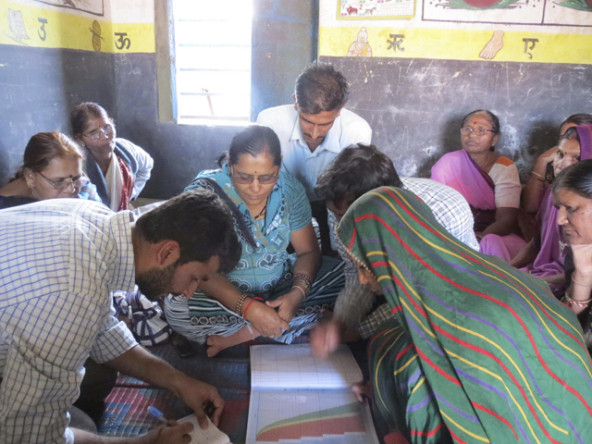In the recent SSIR article “Channeling Change: Making Collective Impact Work,” Fay Hanleybrown, John Kania, and Mark Kramer explain that an inclusive economy and private sector methods are essential ingredients in a successful collective impact approach to attaining international development goals. In a global economy, it makes good business sense to invest in sustainable development. Business students who understand this have the potential to become the world’s future business leaders. However, if one were to ask the typical business school graduate how to tackle development goals or what mechanisms work best, he or she probably wouldn’t be able to answer thoughtfully.
That’s a problem. We need to teach students much more about the complexities around international development. The idea of “doing good” is no longer considered a goal solely of the NGO community, or the government or foreign aid—and “going it alone,” whether in business or development, is no longer the status quo. If business school graduates can’t think critically about creating lasting, large-scale social change through market-oriented, inclusive business models, how can they be effective contributors to an increasingly inclusive economy? How will they navigate the necessary partnerships—working with different players that have varying special interests, whether companies, NGOs, communities, or government entities—to address international development goals?
A few organizations and business schools have embraced this idea, and their experiences are worth considering. The Global Alliance for Improved Nutrition (GAIN) is an example. GAIN is an international organization that launched at the UN General Assembly in 2002 to tackle human suffering caused by malnutrition through efforts to improve access to high-quality, affordable, fortified foods and supplements for children older than six months, and for pregnant and lactating women. Malnutrition has a direct relationship with physical and mental growth and development of children, and therefore impacts school performance, adult productivity, and ultimately the economic development of a country—enough reasons for a business student or a business leader to take an interest in nutrition, as it impacts their bottom line.
Seven years since the start of the GAIN Maternal Infant Young Child Nutrition (MIYCN) program (directed by one of the authors), a comprehensive picture of the success and effectiveness of the different GAIN business models is starting to emerge. To create that picture, GAIN engaged the Global Business School Network (GBSN), a nonprofit that aims to improve the pool of management and leadership talent for the developing world, to perform an assessment of five of its projects, located in Cote d'Ivoire, Kenya and South Africa, and the Indian States of Andhra Pradesh and Rajasthan. These projects aim to increase the availability and accessibility of affordable, high-quality, nutritious diets for children aged between 6-24 months in low-income households.
 An MBA student from Tuck School of Business goes over the books of the Bansawara Factory with the women entrepreneurs who make up the self-help collective that run it in rural Rajisthan, India.
An MBA student from Tuck School of Business goes over the books of the Bansawara Factory with the women entrepreneurs who make up the self-help collective that run it in rural Rajisthan, India.
Are you enjoying this article? Read more like this, plus SSIR's full archive of content, when you subscribe.
GBSN engaged MBA students from Tuck School of Business at Dartmouth, along with faculty mentors, to review the assumptions on which the business cases were built, to determine which investments were most strategic, and which investments across the value chain resulted in improved implementation. The market dynamics differ per country, and results vary according to the context, but some important lessons did emerge around how to maximize both nutrition and business impact when expanding and replicating the programs.
Twenty-five students gained consulting and real-world experience in reaching low-income consumers with low-cost, high-quality products. Subsequently, GAIN worked with GBSN to develop a teaching case that would help students understand the challenges of market-based approaches to nutrition for consumers at the base of the income pyramid, and allow students to walk in the shoes of GAIN directors. The teaching case presents the pressing problem of malnutrition in the five different locations, and puts students in a decision-making position as they try to assess the commercial viability, scalability, and sustainability of the five projects, as well as the effectiveness of their distribution channels, social marketing campaigns, and in some cases, their attempts to influence government policy.
Case studies, whether published or simply developed for classroom lecture and discussion, are extremely effective for engaging large numbers of students in the complex analysis and discussion that is required to understand the multifaceted approaches to international development that are emerging. How else can they learn about what an inclusive economy entails? How else can they develop the skills they’ll need to analyze the impact that development challenges have on the economy, and determine how to address them for the benefit of the poor and for business and economic growth? Through case analysis, students examine a variety of factors—the actors and resources available in a given scenario, the nature of the socio-political-economic environment, human capital capacity, distribution channels, and so on. Little can be more rewarding than the sense of accomplishment that will come from the real-world applicability of their analysis and recommendations.
Support SSIR’s coverage of cross-sector solutions to global challenges.
Help us further the reach of innovative ideas. Donate today.
Read more stories by Marti J. van Liere & Amanda Bullough.

